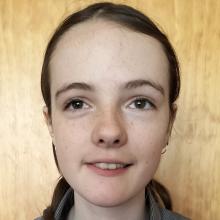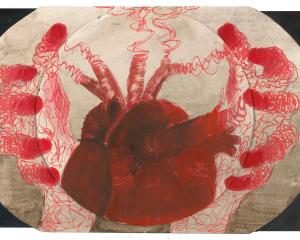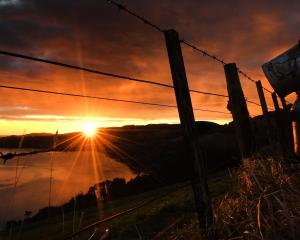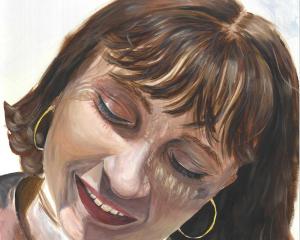
Lake Tekapo

The crunch, crunch, crunch of gravel and snow goes silent as you reach the smooth but slippery footpath of the stone house.
Stepping on to the island-like area that the house stands on, everything becomes a bit clearer. It’s empty.
There’s no-one here.
I ascend the steps to see the stone house in front of me. It’s a little bland.
I wonder "Is this it, just a stone house?" Looking up behind the house, I see an explosion of colours.
The sky brightens up in front of me with blue, purple, white and a shade of red.
The stars are scattered everywhere, some bright and some dull.
The fine line of the long Milky Way is climbing over top of the icy mountains in the distance.
The clear-as-day lake reflects the stars on my face.
The water is flowing quietly.
I’m starting to wonder "how is this real?" I’m so immersed in the sky, I can’t believe that this place even exists.
When the sun starts to change the colour of the sky to orange, the stars are erased.
The sun rises and half of it is shown, peeking over the icy mountains.
As the night becomes more like day, the sun presents itself to the Lake of Tekapo.
Snow on the ground melts.
It melts in my hand.
As the snow melts, all of the gravel is revealed.
Slowly, the breeze dies as a wave of warmth crawls in from the sun.
The lake is shining even brighter; it is a mirror.
All of the lake turns a bit more blue.
I leave the stone house and start to remember the night time.
I remember the clear lake; I remember the icy mountains; I remember the stone house and I remember the beautiful sky.
I saw the lake at night.
Cold, colourful and alone.
But then warm, bright and populated in the day.
Lake Tekapo is big and beautiful, day and night, and is the place I can’t get out of my head.
The truth about tramping

Wrenching open the squeaky hut door, I feel the massive wave of heat flood over me like a tsunami. Smack, smack, whack!
I swat away the blood-sucking vampires of the bush, trying to get inside as fast as I can.
I feel the relief of taking off my hot, sweaty boots and socks.
The burning sun leaks through the windows creating a sauna inside.
The smell of gas and the roar of jetboils cooking up a delicious dinner fill the room.
Relaxing on the veranda, I’m getting eaten alive while taking in the breathtaking views of Lake Alabaster and the towering snow-sprinkled mountains that close in on the lake.
The mirror lake reflects the blinding sun into my eyes; the perfect reflection of native bush surrounds the edges.
New Zealand’s native birds harmonise like a choir.
Trickling, twinkling streams make me feel like I need to pee.
The hot, smelly long drop burns my nose hairs off.
I don’t want to spend a second more there than I need to; I’m in and out like a dart, gasping for sweet fresh air.
Sweaty trampers, smelly socks and insect repellent fill the bunk rooms like a pungent skunk spray.
Winter.
Trudging down the track, I finally feel the relief of seeing the shiny, corrugated iron roof of the hut glistening with rain.
Dead brown leaves lie scattered on the ground; skeleton-like trees surround the hut in the dull mid-afternoon light.
I have to use all the strength left in me to try to break the suction of water and wet smelly socks inside my boots.
Water drips down my entire body. I’m soaked head to toe.
As I walk through the hut, my soggy, wet feet leave footprints behind as a trail of where I have been.
I struggle to break free of the wet, cold clothes that cling to my damp body.
Bundled up in warm, dry clothes, I sit at the window; rain droplets race down.
Outside, wild rivers rumble and roar, breaking the silence of the New Zealand bush.
I gaze at the snow-covered mountains that surround Lake Alabaster.
The lake is hidden in the fog and mist of the late afternoon.
Inside the hut, the fire quietly crackles while trampers chat and play cards.
Squashed in between other trampers, I try to make dinner by the beam of a head torch.
Jetboils roar; the sound takes over the hut.
In front of the fire, wet clothes drip, drip, drip, desperately trying to get dry.
The soggy smell of wet boots and socks creeps up my nose.
The truth about tramping is that it’s not all breathtaking views and beautiful weather like all the photos show.
The truth about tramping is that it’s also about the soaking wet days, the sweaty dry days, the hot stinky long drops and the blood-sucking vampires of the bush.
Taylor Park

The warm glow of the sun’s heat tickled across people’s skin and noses, and the breeze felt as light as a feather.
As the woman took each step on the rocky walking path, a string of chirps and tweets left the birds who lived happily in the trees.
The dark green and ginger coloured leaves swayed now and then in the refreshing breeze and the faint sound of a dog’s bark was heard in the background.
The children laughed joyfully as they swung on the old rust-covered swing set; a look of joy also brightened their small faces.
The long, lush grass danced with the breeze, under golden rays of sunlight, in sync with the sound of cars whizzing past on the tarseal road, and the melody of running, clear water down in the creek.
After being blown away by the wind, dead leaves lay on the ground and stones were flung all over the cracked pathway.
People would often camp here in the park and folks would take their dogs out for a little stroll, and their children out to entertain themselves.
During the day, caravans sat quietly with cars parked beside them.
When night finally approached, the critters of the day were slumbering and the crickets were chirping.
The moon glimmered and gleamed over the park.
The air was chilling to the bone.
Light was piercing out of the houses and caravans.
Night was a time for people to sleep and dream of wonders.
A faint squeaky sound could be heard from the rusty swings as they swayed slightly back and forth and side to side.
Only a few cars could be seen driving down the road, their luminous lights brightening up their path for only a moment before fading again.
Twinkling above, the stars sprinkled across the night sky and the temperature cooled down, and the children returned to their households.
No matter what time of day or night the beauty of nature remains.












